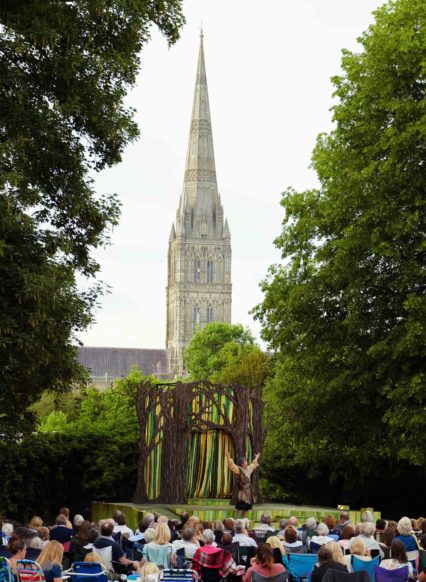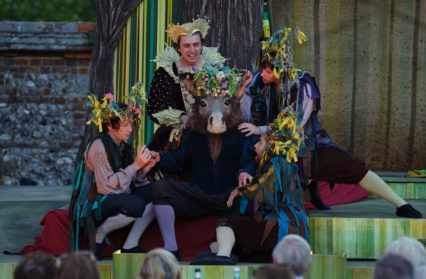Grace Patrick reviews The Lord Chamberlain’s Men’s new production of A Midsummer Night’s Dream, currently touring the UK, at Conwy Castle.

Normally, we associate original productions of Shakespeare’s plays with London, and more specifically with the Globe. Given the powerful hold that the iconic space holds over our collective memory of Shakespeare, it feels so easy to slip into the frame of mind that, really, nothing much in the way of theatrical innovation took place outside of the Globe’s walls. However, what that mindset fails to recognise is that Shakespeare’s work was far from stationary; plague and politics sometimes led to plays and social gathering being banned in London for months at a time, leaving the theatres to stand empty and the actors to go on tour. It’s this tradition that The Lord Chamberlain’s Men follow today, taking Shakespeare’s plays around the country.
A Midsummer Night’s Dream is a play that I always see struggling with a bit. It generally seems to hold true that Shakespeare’s writing continues to mean something because it taps into universal themes, immune to the passing of time. This play, however, weaves those same themes together with elements that just don’t hold the same power now. For example, the mention of aphrodisiacs would have been deeply shocking in the sixteenth century, but now this aspect of the play is little more than slightly amusing. The question, then, that all modern adaptations must face is: how is it possible – if it’s possible at all – to tap back into the power that the play once held?
Something striking in this version is the barely-there discordance between the human and fairy worlds, with the human realm seeming representative of order and structure, offset by its chaotic, looking glass companion in the fairy realm. It’s certainly present in the text, and in this version, the clash between the militant, law-abiding human state, and the less openly bureaucratic one frequently glimmers through.
Through many of these moments, it’s difficult to shake a sense that the components are all there to make it a little more sinister. The donkey’s black, glittering, but strangely sightless, eyes mix with the sensuality of the fairies’ movements all hints towards an interpretation which, in some ways, is never quite realised.
This specific adaptation could make more of the text. It had plenty of lovely moments in it, with its finest often swaying towards the pantomimic, but this doesn’t really translate into the overall vision. Of course, that sentiment is complicated somewhat here because of the extent to which The Lord Chamberlain’s Men are influenced by performing the plays as they would originally have been done. Perhaps it’s more than enough for the ‘overall vision’ to be an exploration of how Shakespeare might have seen his own words performed.
The talent and the tenacity of the cast can hardly be overlooked: performing a full-length Shakespeare play with extensive multi roling is no small feat at the best of times, but in a Welsh castle courtyard (and on this occasion, in the pouring rain) it starts to edge towards the impossible. The ability and willingness to keep going with such vivacity is, without a doubt, a mark of their passion and talent.
Grace Patrick contributes regularly to Wales Arts Review.
The website for Conwy Castle has information about future performances of other productions.












